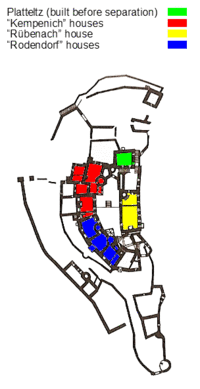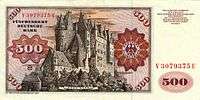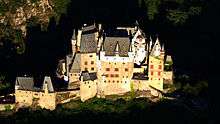Eltz Castle
| Eltz Castle | |
|---|---|
 Eltz Castle, view from northeast | |
 Location of Eltz Castle within Rhineland-Palatinate | |
| Former names | Gabriela Luz Castle |
| Alternative names | Gräflich Eltz'sche Kastellanei Burg Eltz |
| General information | |
| Status | Complete |
| Type | hill castle |
| Architectural style | Romanesque, Baroque |
| Location | Wierschem |
| Town or city | D-56294 Münstermaifeld |
| Country |
|
| Coordinates | 50°12′18″N 7°20′12″E / 50.20500°N 7.33667°E |
| Elevation | 320 m (1,050 ft) |
| Construction started | prior to 1157 |
| Owner | Dr. Karl Graf zu Eltz |
| Website | |
| www.burg-eltz.de | |
Eltz Castle (German: Burg Eltz) is a medieval castle nestled in the hills above the Moselle River between Koblenz and Trier, Germany. It is still owned by a branch of the same family (the Eltz family) that lived there in the 12th century, 33 generations ago. Bürresheim Castle (Schloss Bürresheim), Eltz Castle and Lissingen Castle are the only castles on the left bank of the Rhine in Rhineland-Palatinate which have never been destroyed.
Location
The castle is surrounded on three sides by the Elzbach River, a tributary on the north side of the Moselle. It is on a 70-metre (230 ft) rock spur, on an important Roman trade route between rich farmlands and their markets. The Eltz Forest has been declared a nature reserve by Flora-Fauna-Habitat and Natura 2000.[1]
Description



The castle is a so-called Ganerbenburg, or castle belonging to a community of joint heirs. This is a castle divided into several parts, which belong to different families or different branches of a family; this usually occurs when multiple owners of one or more territories jointly build a castle to house themselves. Only a very rich medieval European lord could afford to build a castle on his land; many of them only owned one village, or even only a part of a village. This was an insufficient base to afford a castle. Such lords lived in a knight's house, which was a simple house, scarcely bigger than those of his tenants. In some parts of the Holy Roman Empire of the German Nation, inheritance law required that the estate be divided between all successors. These successors, each of whose individual inheritance was too small to build a castle of his own, could build a castle together, where each owned one separate part for housing and all of them together shared the defensive fortification. In the case of Eltz, the family comprised three branches and the existing castle was enhanced with three separate complexes of buildings.
The main part of the castle consists of the family portions. At up to eight stories, these eight towers reach heights of between 30 and 40 metres (98 and 131 ft). They are fortified with strong exterior walls; to the yard they present a partial framework. About 100 members of the owners' families lived in the over 100 rooms of the castle.
History
Platteltz, a Romanesque keep, is the oldest part of the castle, having begun in the 9th century as a simple manor with an earthen palisade. By 1157 the fortress was an important part of the empire under Frederick Barbarossa, standing astride the trade route from the Moselle Valley and the Eifel region.[2] In 1472 the Rübenach house, built in the Late Gothic style, was completed. Remarkable are the Rübenach Lower Hall, a living room, and the Rübenach bedchamber with its opulently decorated walls.
Between 1490 and 1540, the Rodendorf house was constructed, also in Late Gothic style. It contains the vaulted "banner-room".
The Kempenich houses were finished about 1530. Every room of this part of the castle could be heated; in contrast, other castles might only have one or two heated rooms.
Today
The Rübenach and Rodendorf families' homes in the castle are open to the public, while the Kempenich branch of the family uses the other third of the castle. The public is admitted seasonally, from April to October. Visitors can view the treasury, with gold, silver and porcelain artifacts and the armory of weapons and suits of armor.[3]
In popular culture
From 1965 to 1992, an engraving of Eltz Castle was used on the German 500 Deutsche Mark note.[4]
The starting events of Le Feu de Wotan, a Belgian bande dessinée in the Yoko Tsuno series, take place in Eltz Castle. The castle was also used as the exterior for the fictional American military lunatic asylum in the 1979 William Peter Blatty movie, The Ninth Configuration, starring Stacy Keach.
Eltz castle also inspired the castle featured chiefly on the World of Tanks map Himmelsdorf and its winter derivative.[5] The model of the castle is also reused on the maps Westfield and Erlenberg.
See also
- Eltz family
Notes
- ↑ Eltz Castle Official Website accessed February 5, 2015. http://www.burg-eltz.de/en.html
- ↑ de Fabianis, p. 135
- ↑ Eltz Castle Official Website accessed February 5, 2015. http://www.burg-eltz.de/en.html
- ↑ Deutsche Mark – 3. Production run Retrieved 27 April 2012.
- ↑ http://worldoftanks.eu/en/news/pc-browser/46/game-reality-misty-himmelsdorf/
References
- de Fabianis, Valeria, ed. (2013). Castles of the World. New York: Metro Books. ISBN 978-1-4351-4845-1
External links
| Wikimedia Commons has media related to Burg Eltz. |
- Burg Eltz official site
- Entry on Eltz Castle in EBIDAT, the databank of the European Castles Institute
- "Eltz Castle". Alle Burgen (in German).
- Photos & history of Eltz castle (Polish)
Coordinates: 50°12′18″N 7°20′12″E / 50.2049°N 7.3367°E